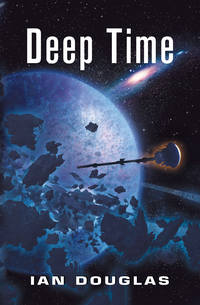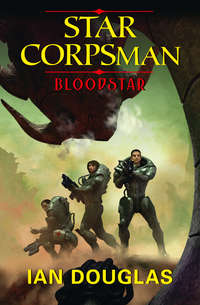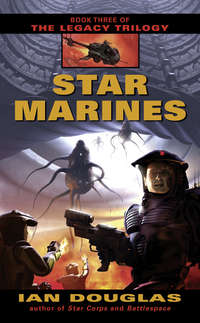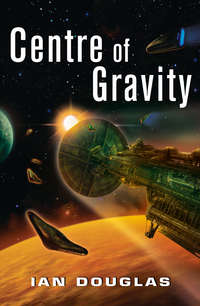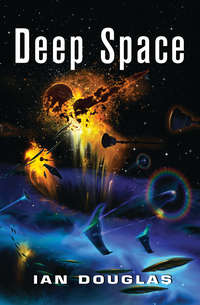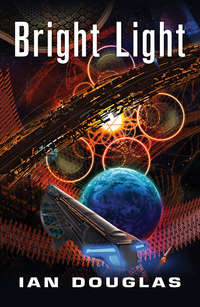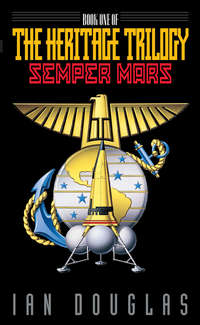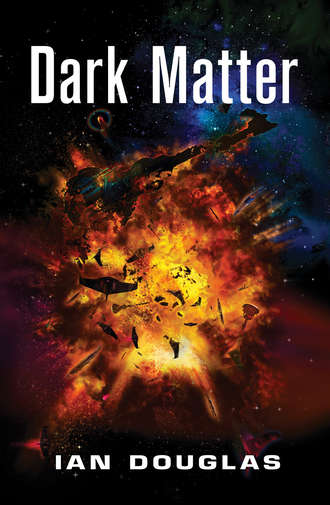
Полная версия
Dark Matter
But the Confederation had been scoring victories as well. Besides annihilating Columbus, they’d destroyed a number of USNA orbital assets, were effectively in control of the SupraQuito space elevator, and had brought together a large fleet with which they were effectively dominating solar space. Mexico and Honduras had seceded from the USNA and invaded South California, Texas, and two other districts. Pan-European forces had occupied the Manhat Ruins and parts of the Virginia and Carolina Periphery coastlines. The USNA military was badly stretched, outnumbered, and just hanging on. Even with Hegemony and Theocracy help, the issue was in doubt.
“Maybe Konstantin has some information,” Koenig said.
Whitney grinned. “The Great Konstantin sees all . . . knows all . . .”
It was a running joke within the emergency command post. The computer array in Tsiolkovsky on the moon had been instrumental in a number of successes in the war so far—not least of which had been opening negotiations with the Theocracy and with the Chinese.
“Sometimes I’m afraid that it does all,” Koenig replied.
But he opened the channel anyway.
The artificial intelligence known as Konstantin was very much an enigma, and one that many—perhaps most—humans did not entirely trust. Computer AIs had surpassed the commonly accepted measures of human intelligence four centuries ago, and the Konstantin Array was a fifth-generation AIP running within a network of DS-8940 Digital Sentience computers. AIP stood for artificial intelligence programmed. Humans hadn’t programmed Konstantin; machines had, by copying large chunks of code and weaving them together in ways that often surprised their human overseers.
Theoretically, computer minds programmed by computers still carried the same constraints as their human-programmed counterparts. While Konstantin was theoretically 1010 times more powerful in terms of synaptic complexity than a human, he still possessed what was comfortingly known as limited purview. He was very good at processing data and he could follow orders quite well, but computers weren’t supposed to be able to make decisions independently of humans, nor were they supposed to demonstrate what was theoretically a purely human trait: creativity.
And yet, Koenig knew, Konstantin had displayed remarkable creativity several times already, most notably when he’d quietly opened negotiations with the Theocracy and the Hegemony. No human had directed him to do so.
The fact that he had might well mean victory for the USNA.
Koenig gave a wry smile. He was used to calling AIs “it,” . . . but over the past few months, Konstantin for him had definitely become a he.
After a delay of a few moments, a window opened in Koenig’s mind. A balding and white-haired man in old-fashioned clothing and gold pince-nez looked at him from behind a book with its title in Cyrillic letters. Behind him were the anachronistic screens of a circular workstation complete with floating monitor displays and free-floating transparent control panels. “Ah, Mr. President,” the AI’s electronic avatar said. “I’ve been expecting you.”
The original Konstantin Tsiolkovsky had been a Russian schoolteacher in the early 20th century, a hermit who’d seemed strange, even bizarre, to his neighbors, but who’d been convinced that one day Humankind would spread out to the stars. With Oberth, Goddard, and Korolyov, he’d become known as one of the fathers of modern spaceflight . . . the father, in fact, since he’d predated the others.
“I assume you’ve been watching the situation in Geneva,” Koenig said.
As always, there was an awkward two-and-a-half-second pause as Koenig’s words crawled up to the moon, and the AI’s reply crawled back.
“Of course. We expected something of the sort, of course, but events appear to be moving with unexpected speed.”
“You expected a revolution?”
“There has been considerable public outcry over the destruction of Columbus, particularly in Europe,” Konstantin replied. On the screens behind him, European soldiers were fighting in the ravaged streets of Geneva. It was night over there, the sky reflecting the light of a burning city. In the background of one monitor, Koenig recognized the sprawl of the Plaza of Light in Geneva’s heart, dominated by the immense statue Ascent of Man. Hover tanks were moving toward the Confederation’s Ad Astra Government Complex.
“Too,” Konstantin continued, “the war has been dragging on without significant victories for two months. Anticipation for an early and easy victory has given way to doubts about the morality or legality of the war.”
“This could be the end of it, then,” Koenig said.
“Do not assume a USNA victory yet, Mr. President. The rebels appear to be a faction under General Janos Matonyi Korosi, formerly a hard-liner within the Confederation Senate. He has wanted President Roettgen’s job and power for some time, now, and he may see this coup as a means not only of defeating you, but to opening negotiations with the Sh’daar directly, ending the Sh’daar War, and presenting himself as Earth’s savior. There is also a personal aspect.”
“What aspect?”
“His brother was Karl Mihaly Korosi, executive officer of the destroyer Mölder.”
“Ah.”
Mölder had been one of the Pan-European warships that launched the deadly nano-disassembler attack on Columbus. She’d been destroyed by a spread of nukes fired from the Missouri. Moments later, the bombardment vessel Estremadura had fired six nano-D warheads. Five had been intercepted out in space by the frigate John Paul Jones, but the sixth had destroyed Columbus, D.C.
Koenig recalled that Ilse Roettgen, the president of the Confederation Senate, had seemed shocked when she learned that Columbus had been hit by nano-D. He was as sure as he could be that she’d not been putting on an act—and that suggested that rogue elements within her own government or military forces had been operating on their own, behind her back. And if Korosi’s brother had been killed on the Mölder . . .
That connection, tenuous as it was, suggested that the hard-liners in the Geneva government had planned and carried out the attack on Columbus, and now were using the situation to seize power. Lovely.
“You think General Korosi is out for revenge, then?”
“Unknown. I am simply relying on Big Data to build up a comprehensive picture of what is going on over there. I have been unable to penetrate Pan-European electronic security.”
That, of course, would have been one of the first things Konstantin tried, and the Europeans would have expected that, and have had their electronic defenses in place. In fact, one of the causes of the war had been their attempt to capture the Konstantin Array, deploying an armored force across the lunar surface from the Confederation base at Giordano Bruno. They’d been stopped on the north rim of Tsiolkovsky Crater by a small force of USNA Marines, but it had been a close-run thing. Koenig had gathered through his daily security briefings that the Confederation had been trying to electronically compromise Konstantin ever since, trying and failing.
So far . . .
Curious, Koenig glanced at the book Tsiolkovsky’s image was holding. He neither spoke nor read Russian, but a translation program riding within his cerebral implant overlaid his mental view with the book’s title in English.
The Will of the Universe: The Unknown Intelligence, by Konstantin Tsiolkovsky, Kaluga, 1928.
Koenig had never heard of it, but wondered if Konstantin was allowing him to see that title for some specific reason. The AI array could be remarkably subtle at times.
“So, do you have any recommendations?” Koenig asked. If others mistrusted the giant AI array, even if he, Koenig, still had misgivings, he nevertheless had been relying more and more on the powerful AI’s advice. Konstantin could mine what was called Big Data, pulling tens of thousands of minute, often unrelated facts from a vast sea of information floating Out There in the electronic ether of Global Net and the various smaller, local news and communications networks. He could piece together disparate data and reveal connections, conclusions and intelligence of which no human observer could have been aware.
“I have been tracking Confederation communications exchanges, and conclude that the rogue component of their government is staging their operation from here.”
One of the screens shifted from the streets of Geneva to a scene in deep space, the vast, ringed glory of Saturn in the distance, a small rock-and-ice moon in the foreground. Koenig read the information scrolling up the side of the screen. “Enceladus? What’s at Enceladus?”
“Evidently, the renegade faction’s headquarters. The evidence suggests that they have been planning this for a very long time. I suggest a Navy-Marine task force tasked with capturing the surface base and any senior personnel stationed there.”
“That may not be easy,” Koenig said. “We’re stretched damned tight right now.”
“I am aware of this. The USNA may need to disengage at several points—retreat—in order to free forces for the strike. Some of the slack might be taken up by Chinese and Russian forces in Asia.”
“We’ll need ships. And right now, most of what we have is protecting the space elevator . . . or in low orbit High Guard, waiting to block another nano-D strike.”
“I do not need to tell you, President Koenig, that a purely defensive stance will, ultimately, fail. Your best chance lies in going over to the offensive. And speed is of the essence.”
“Eh? Why? What else have you heard?”
“Nothing definite. But some of my data mining has revealed an unsettling possibility.”
Koenig sighed. “Okay. What is it?”
“It is possible that the renegade Confederation government has been in direct contact with the Sh’daar, and they may be on their way here.”
The words hit Koenig like a hammer blow. “Christ! The Sh’daar? Here?”
“It may be a good idea,” Konstantin said, “to attempt the destruction of your human enemies before having to face something considerably more exotic . . . and dangerous.”
And Koenig could only nod in dumb agreement.
Chapter Three
20 January 2425
USNA CVS America
Omega Centauri
1750 hours, TFT
The Rosette Aliens were letting them go.
Gray scarcely allowed himself to believe it at first . . . but when a number of those bright silver eggs took up positions around the task force, a few thousand kilometers out and escorted them toward their Alcubierre jump point, effortlessly matching their acceleration, he had to admit that that was the case.
“I just wish we’d been able to open a comm channel with them,” Gray said. He was on the flag bridge, now, sitting at his partially enclosed workstation above and behind the captain’s chair.
“I think,” the CAG said quietly in his mind, “that we have been in communication with them.”
“What do you mean?”
“They turned our recon pilot around and dropped him back alongside the America,” Connie Fletcher said. “Without harming him . . . and that’s important. Kind of like shooing a curious kitten away from the power outlet.”
“We began accelerating out-system, and they paced us,” Acting Captain Gutierrez pointed out. “Seems like pretty clear communications to me. ‘Here’s your hat, what’s your hurry? Don’t let the door slam your ass on the way out.’ ”
“I think you’re right. No specific response on the messages we sent them. I think it possible that they simply aren’t interested in us.”
“Well, Admiral . . . a K-3 civilization might not find a K-1.2 all that interesting.”
“Coming up on our jump point, sir,” the Helm reported. “Twenty seconds.”
The view of the stars outside of the America was weirdly distorted by the carrier’s velocity, now just a hair less than the speed of light itself. The entire universe, the light of all the stars in the Omega Centauri cluster, had been squeezed into a bright ring of light forward. The seconds dwindled away . . .
. . . and then America’s AI pulled the already tightly distorted space around the carrier in, creating a tight bubble that was not, strictly speaking, a part of normal space. Metaspace, the physicists called it . . . and the nonmathematical explanation declared that while a material object such as an atom or a star carrier could not travel faster than light—or, indeed, even reach light speed—there was nothing preventing the space within which it rested from doing so. The Mexican physicist Miguel Alcubierre had worked out the theory in 1994, and the first FTL transit had occurred less than a century and a half later.
At maximum drive, now, America hurtled through metaspace for home.
Gray willed himself to relax. He’d not realized how tense, how stressed he’d been at the prospect of confronting the Rosette Aliens. Sh’daar client species—those encountered so far by Humankind, at any rate—tended to be somewhat more advanced than humans. Higher technology translated as greater power, faster ships, and more deadly weaponry, and staying ahead of such an enemy, meeting him and outfighting him despite his technological lead, was a dangerous and uncertain game.
The Rosette Aliens were far more advanced than any species yet encountered by Earth. A technological difference representing tens of thousands or even millions of years instead of a century or two could not be overcome by grit, cleverness, or determination.
Gray leaned back in his command chair and opened a series of data links. He wanted to see what there was in America’s memory about Kardashev classifications.
He was wondering if the Rosette Aliens might be induced to ally with Earth against the Sh’daar . . . or if Earth would one day have to fight them.
America Data Files
Extant Galactic Civilizations
Classification: Green-Delta
KARDASHEV CLASSIFICATION: First proposed by astronomer Nikolai Kardashev in 1964 as a means of classifying hypothetical galactic civilizations in terms of the amount of energy they use. In its original form, it stated that a Type I civilization utilizes all of the available energy resources of its home planet; while a Type II uses the energy of its entire star system, and a Type III uses the resources of an entire galaxy. Lacking useful fine detail, this early scale was later refined and expanded.
Currently, galactic civilizations, both observed and hypothetical, can be assigned a more precise Kardashev number using the formula K = log10MW/10, where K is the Kardashev level, and MW is the energy, in megawatts, used by the civilization in one year.
Type 0: Established as a baseline, a K-0 civilization utilizes roughly 1 million watts (1 MW) of energy. Energy and raw materials are extracted from crude, organic-based sources such as wood or fossil fuels. Earth’s civilization during the late twentieth century when the Kardashev scale was first proposed, utilizing roughly 15 terawatts globally, would have been defined as approximately K-0.71.
Type 1: A civilization utilizing all energy available on a planetary scale. For Humankind, this would be an energy capability equivalent to Earth’s insolation, the radiation it receives from the sun, or around 1016 watts. It is capable of interplanetary and possibly limited interstellar travel and colonization, of planetary engineering, and can utilize a variety of energy sources, including but not limited to fission, fusion, antimatter, and zero-point energy. Earth’s interstellar civilization in 2425 utilizes an estimated 1018 watts, and therefore has a Kardashev level of approximately 1.2.
Type 2: Sol has a luminosity of about 4 × 1026 watts, and this would be the energy usage typical of a Type 2 civilization. The ancient ur-Sh’daar, who manipulated entire stars to create hyperdimensional gateways, are estimated to have utilized around 1034 watts, and would have been considered to be Kardashev 2.7 at the time they entered their technological singularity 876 million years ago. Such a civilization would be capable of interstellar and possibly local intergalactic travel, as well as stellarforming projects such as Dyson spheres, Dyson swarms, and star mining.
Type 3: The Milky Way galaxy has a total luminosity of about 4 × 1037 watts. While capturing the totality of a galaxy’s radiation output is problematic, a civilization generating and utilizing energy on this scale would be considered to be Type 3. The ancient civilization or civilizations variously known as the Builders, the Starborn, or the Stargods, who are believed to have been capable of time travel and of large-scale stellarforming, are almost certainly at least Type 3.0. Such cultures would be capable of extragalactic travel and to perform stellar engineering on a galactic scale.
Type 4: This is the designation for a purely speculative category of cultures able to use energies on the scale of galactic superclusters, or approximately 1042 watts.
Type 5: Also speculative, a K-5 civilization would utilize energy equivalent to the output of the visible universe, or very roughly 1049 watts.
Type 6: Even more speculative. Type 6 civilizations would span a number of parallel universes, and might engage in “ ’brane forming” activities such as creating or manipulating entire universes. Since this scale clearly surpasses concepts based on current scientific understanding, no data on energy usage or predictions as to a Type 6 culture’s technological capabilities are possible.
When the Kardashev scale was first introduced, the underlying concept suggested that galactic civilizations might literally use all of the energy available from their local star or galaxy. The Dyson sphere, proposed by Freeman Dyson four years earlier, might represent an attempt to trap all available stellar energy, allowing Earth to detect a K-2 civilization by modifications to its light output, or by recognizing the radiated infrared emissions of that civilization’s industrial processes. The development of zero-point energy obviates the need to efficiently trap the star’s light, however, since the energy drawn from hard vacuum represents a far more abundant source of power than stellar fusion. Nevertheless, the overall amount of energy utilized by the civilization, can still be quantified as the amount available from a world, a star, or a galaxy, no matter what the actual source of that energy might be.
Obviously, the breakdown presented here is extremely rough—a guide only—and can make no predictions of the specifics of a given advanced culture’s technologies, or of its motivations, philosophies, or attitudes toward other species.
Where, Gray wondered as he finished the download and closed the channel, did the modern Sh’daar fall on this scale? The data specifically mentioned the ur-Sh’daar, the empire or collective of mutually alien species that had inhabited a small, irregular galaxy devoured by the Milky Way 876 million years ago. At that time, shortly before the smaller galaxy had been torn apart by intergalactic tidal forces and the empire disrupted, the ur-Sh’daar had entered its version of what was commonly called the Technological Singularity. Also known as the Vinge Singularity, after the mathematician and author Vernor Vinge, who first popularized the idea in the late twentieth century, the singularity was broadly seen as that point in a civilization’s development where organic intelligence merged with artificial intelligence in ways that utterly transformed the meanings of words like life and intelligence. For humans, the so-called GRIN technologies were seen as the drivers of this change: Genetics, Robotics, Information systems, and Nanotechnology.
Twenty years ago, Gray and America’s battlegroup, under the command of Admiral Alexander Koenig, had used one of the enigmatic TRGA cylinders to cross a very great deal of both space and time to reach the doomed galaxy—known to its inhabitants as the N’gai Cloud. There, they’d learned about the Schjaa Hok, the Transcending or Time of Change, when the highly advanced species of the ur-Sh’daar had entered a period of transcendence, vanishing from the ken of minds still firmly anchored in what they thought of as Reality. Gray had seen downloaded records of that event almost 900 million years in the past, and was still shaken by it. Of particular interest was the fact that not all members of that long-ago civilization had transcended. Called Refusers—those who had refused the augmentation and the advances in genetics and computer enhancement of an artificially directed evolution—the remnant species had rebuilt a shattered civilization from scratch . . . the civilization Humankind knew now as the Sh’daar.
Traumatized as a collective of intelligent species by the Time of Change, the Sh’daar had eventually recovered, spreading not only into the much larger galaxy that was devouring the N’gai Cloud, but ultimately through time as well, at least in a limited sense. Within the current epoch of the Milky Way, they’d established themselves as a dominant, apparently electronic civilization that had first appeared a few million years ago, creating a network of client races, the va Sh’daar. They seemed dedicated to the active suppression of higher technologies among their clients—in particular the GRIN drivers of the singularity that had wrecked their culture ages before. Newly encountered species were given the opportunity to join the Sh’daar Collective freely. If the offer was rejected, the new species were forced; Humankind had received the Sh’daar Ultimatum, as it was known, in 2367, through the recently contacted Agletsch. A steady, grinding series of wars had been waged with various va Sh’daar races for the following thirty-eight years.
Then, twenty years ago, the Sh’daar were beaten . . . or, at least, so it had appeared. America’s battlegroup had passed through a TRGA cylinder and emerged at the heart of the N’gai Cloud 876 million years in the past—a temporal end run that seemed to have panicked the Sh’daar more than the possibility of a new technic singularity. The resulting truce engineered by Admiral Koenig had promised an end to hostilities, and had actually held for two decades. But recently, Sh’daar client species had been testing human resolve once again. The Confederation insisted that Humankind could not long hold out against superior alien technology and numbers; better to surrender now, Geneva insisted, before Earth was obliterated.
The difference in cultural philosophies between Old World and New, differences between two alternative and mutually contradictory views of Humankind’s future in the galaxy, had, along with other more mundane problems, resulted in the current civil war back home.
“The Alcubierre bubble is stable,” Captain Gutierrez reported, jerking Gray’s full awareness back to America’s flag bridge. “We are currently ’cubing at five point three. We should reach the local TRGA in eight hours.”
“Very well,” Gray replied, and he smiled. ’Cubing was naval slang for traveling under Alcubierre Drive. The number was how many light years America was now crossing in a day.
The Sh’daar, with their distinct advantages in technology over what humans were capable of right now, had obviously missed an important point. That series of wars between their clients and Humankind had put considerable pressure on the Confederation for more than half a century . . . but what the Sh’daar seemed to have missed was the fact that human technology tended to advance much more rapidly during times of war than during peace. Intelligence believed that they were avoiding launching an all-out attack that might easily drive humanity into extinction; they wanted another pliant and cooperative va Sh’daar client, not a glassed-over cinder that once had been an inhabited world. Obviously, a galactic culture capable of merging old stars to create new would have no trouble at all annihilating Sol if they so chose. Forcing a stubborn Homo sapiens to accept Sh’daar dictates on permissible levels of technology, evidently, was a lot harder.
When forced to fight, however, Humankind was always tinkering, trying to come up with a better hand ax . . . a better spear . . . a better high-energy laser. The Alcubierre Drive was a case in point. Theoretically, there was no upper limit to a starship’s pseudovelocity, but in practical terms everything depended on how much energy a starship could generate and direct to the artificial singularities that served to pull space in on itself. When Columbia, the first human starship, had ’cubed to Alpha Centauri in 2138, she’d managed the passage in six and a half months . . . a pseudovelocity of 0.095 light years per day. Until recently, most naval vessels had managed an Alcubierre rate of around 1.8 light years per day, though high-velocity message couriers could manage better than 5 light years per day.




